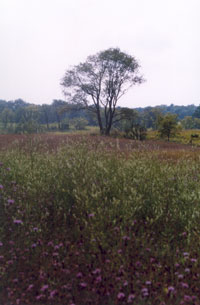 |
||||
      |
||||
|
(preserving, cont.) This growing trend in land conservation is what ultimately convinced the Cegielskis to buy their house. As young professionals, Heather and Kevin were living in their first home in the river town of Prescott, when they decided to try to find a piece of rural property that would still allow each of them to commute to work in the Twin Cities area. But nearly every piece of property they looked at was either too expensive or too likely to become the next victim of western Wisconsin’s rapid development. So when the Cegielskis found a house on 10 acres of wooded land that was not only affordable but adjoined 350 acres of land that would never be developed, they were sold. “The sole reason we bought our house is because that land is in a land trust and won’t be developed,” Cegielski says. “We might not own it, but we benefit from it every bit as much as the people who are working to preserve it.” And while the Cegielskis are enjoying the land, they also can enjoy the fact that they benefit from the land without dealing with the costs and paperwork involved in conserving land through a land trust. Individual landowners who are interested in preserving their property must first obtain a landowner worksheet, according to Gauger. On this worksheet, they must write what they want to do with the land, why they want to preserve it and how they envision the property in the distant future. A land trust employee will then call the landowner to talk about goals and concerns relating to the property. The employee follows this with a visit to inspect the property and discuss the uses and restrictions the landowner wants to apply to the property. Although all landowners who preserve their land have to agree not to develop the land, they work with the land trusts to decide which of their other rights to the land they want to give up, such as the right to log the property or hunt and fish on the land, Gauger says. He emphasized that landowners do not have to open their land to the public or share it with anyone else if they decide to preserve it. Once the details of how the land will be handled are worked out, land trust employees work with the landowner to write up a land preservation agreement. The landowners then take this written agreement to an attorney to make sure it accurately represents their interests. When that checks out, the land is appraised and title work is done on the property. Once all of this has been finalized, everything is signed and recorded, ensuring the land is officially in a preservation agreement. The cost of this process amounts to about $10,000 on average, Gauger says. But he points to incentives for landowners considering preserving their property. In addition to the satisfaction of knowing that the piece of property will be preserved forever, landowners also get tax deductions in the form of non-cash charitable deductions. The land trust also can receive grant money from the government or other agencies to partially compensate the land owner for preserving the land. This is especially likely if the land is unique and in dire need of preservation, Gauger says. But Gauger does not think the costs of land preservation have affected this growing trend. In fact, he expects to see an increase of interested landowners in the future. “I really think we’re just scratching the surface in private land preservation. Many people don’t know a whole lot yet about land trusts or what we do. As word continues to trickle out, I think there will be a steady increase,” Gauger says. And Gauger may be right. Stuart and Phoebe Parsons of Cedarburg, are two of a growing number of people who are deciding to conserve their land. The Parsons put 157 acres of their property into a land preservation agreement several years ago after they discovered that much of the marshy land was a breeding ground for Great Blue Herons. “When we found out it was a heron rookery, we decided no one should ever build on it,” Phoebe Parsons says. The Parsons bought the land in 1967 simply because it came with their house. They did little with the land until several years ago, when the pressure to develop started to increase. “When we bought it, this land was pretty far out in the country. Now, Cedarburg is growing like mad and is growing out,” Phoebe Parsons says. “There’s a lot of pressure here, in this part of the county, to develop.” Unwilling to succumb to the pressure to develop their land, the Parsons started looking for a means to preserve the land. They ended up working with the Ozaukee Washington Land Trust and put all 157 acres in a preservation agreement. They were lured by both the prospect of permanently preserving the heron breeding grounds on their land and the tax deductions. Today, the Parsons’ land is still private and they continue to allow it to exist in its natural state. The only change is that now a land trust employee walks through the property once a year to make sure the Parsons are abiding by the rules of their preservation agreement. The Parsons also mow paths through the land when it is dry so they can enjoy the herons and they also try to manage any invasive species they notice in the property’s delicate ecosystem. When they first put their land into a preservation agreement, Phoebe Parsons says the Wisconsin Department of Natural Resources examined the land and estimated that there were as many as 60 heron nests on the property. “This is just a really good thing to do. When we moved out here, it was really rural. Now everything is getting really developed,” Phoebe Parsons says. “And this is especially a good thing to do if you have a habitat that is really important on your property.” |
|
|
|
|||
|
|||
